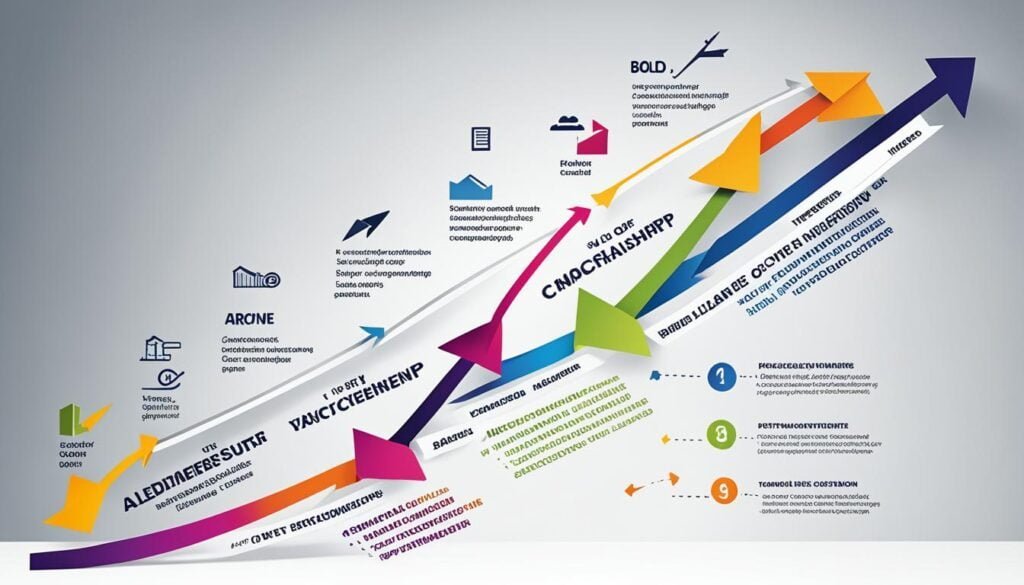Welcome to our article on achievement-oriented leadership! In today’s competitive and results-driven business world, effective leadership skills are crucial for success. One leadership approach that has gained recognition is achievement-oriented leadership. This style of leadership focuses on setting challenging goals, encouraging accountability, and fostering a supportive work environment.
Leaders who embrace achievement-oriented leadership adopt a goal-driven approach, prioritizing tangible results and effective communication. They actively engage with their team and provide ample feedback to ensure continuous improvement. By instilling confidence and promoting a results-focused mindset, achievement-oriented leaders can drive team productivity and help organizations reach their goals.

Key Takeaways:
- Achievement-oriented leadership emphasizes setting challenging goals and holding the team accountable.
- It promotes effective communication and feedback to drive continuous improvement.
- A supportive work environment is created, boosting motivation and productivity.
- Achievement-oriented leadership is best suited for high-performance environments and specific goal-oriented situations.
- Leaders can follow different types of achievement-oriented leadership, including directive, participative, and transformational styles.
Defining Traits of Achievement-Oriented Leaders
Achievement-oriented leaders possess specific defining traits that contribute to organizational success. They understand the importance of setting challenging goals that inspire their team and actively engage with team members to drive performance.
One defining trait of achievement-oriented leaders is their accountability. They take full ownership of their goals and ensure that they are met. These leaders prioritize the well-being and growth of their team, providing the necessary support and guidance to help individuals develop and excel.
Results-focused is another key trait of achievement-oriented leaders. They consistently keep the end goal in sight and make decisions that align with achieving tangible outcomes. By emphasizing open and effective communication, these leaders foster a transparent work environment that encourages collaboration and innovation.
“Achievement-oriented leaders set challenging goals, actively engage with team members, and create a supportive work environment.”
Ultimately, achievement-oriented leaders understand that their success is dependent on the success of their team. By exhibiting these defining traits, they create a culture of achievement that propels organizations toward their goals.
| Traits of Achievement-Oriented Leaders | Description |
|---|---|
| Accountability | Achievement-oriented leaders take responsibility for their goals and prioritize the growth and well-being of their team. |
| Results-Focused | These leaders consistently keep the end goal in sight and make decisions that align with achieving tangible outcomes. |
| Supportive Work Environment | Achievement-oriented leaders foster open and effective communication, encouraging collaboration and innovation within their teams. |
Benefits of Achievement-Oriented Leadership
Achievement-oriented leadership offers numerous benefits that contribute to team productivity and the achievement of organizational goals. By adopting this style of leadership, leaders can create a work environment that fosters growth, collaboration, and motivation.
Encourages Goal Setting
One of the key benefits of achievement-oriented leadership is the encouragement of goal setting. By setting clear and challenging goals, leaders provide employees with a sense of direction and purpose. Goals help individuals prioritize their efforts and work towards achieving specific targets. This focus on goal setting ensures that everyone within the organization is aligned and working towards a common objective.
Drives Innovation
Achievement-oriented leadership promotes innovation within teams and organizations. By setting ambitious goals, leaders inspire team members to think outside the box and seek creative solutions to overcome challenges. This emphasis on innovation fosters a culture of continuous improvement and allows organizations to stay ahead of the competition.
Promotes Collaboration
Creating a common goal is a vital aspect of achievement-oriented leadership. By setting goals that require collaboration and teamwork, leaders foster a culture of cooperation and unity. Team members are encouraged to work together, leveraging their individual strengths and expertise to achieve shared objectives. This collaborative environment enhances communication, coordination, and overall team performance.
Improves Motivation
Achievement-oriented leadership improves motivation among team members. By setting challenging goals and providing regular feedback, leaders instill a sense of purpose and drive in their employees. The clear pursuit of goals gives individuals a tangible target to strive for, increasing their enthusiasm and dedication. This heightened motivation leads to higher levels of engagement and productivity.
| Benefits of Achievement-Oriented Leadership |
|---|
| Encourages goal setting |
| Drives innovation |
| Promotes collaboration |
| Improves motivation |
When to Use Achievement-Oriented Leadership
Achievement-oriented leadership is a valuable approach that can be implemented in various contexts to drive success and maximize team performance. This leadership style is particularly effective in high-performance environments, such as sports teams, research and development departments, and competitive business environments. By utilizing achievement-oriented leadership in these settings, leaders can create a culture of excellence and motivate employees to reach their full potential.
One key benefit of achievement-oriented leadership is its ability to motivate employees. This style of leadership empowers individuals by setting challenging goals and providing continuous feedback. By establishing clear objectives and providing constructive criticism, leaders inspire their team members to push their limits and achieve exceptional results. This, in turn, cultivates a high-performance environment that drives productivity and fosters continuous improvement.
Achievement-oriented leadership is also ideal when specific goals need to be reached. Whether it’s launching a new product, hitting sales targets, or completing a project on time, this leadership approach incentivizes employees to focus their efforts on achieving those specific goals. By emphasizing tangible outcomes, leaders can align their team’s efforts with the desired results, increasing the likelihood of success.
It is important, however, to consider the context in which achievement-oriented leadership is applied. While it can be highly effective in motivating employees and reaching specific goals, this leadership style may not be suitable in situations where there is no clear objective or when employees may become overwhelmed by the pressure. In such cases, alternative leadership styles that prioritize collaboration or employee development may be more appropriate.
In summary, achievement-oriented leadership is a powerful tool that can be utilized to motivate employees and reach specific goals, especially in high-performance environments. By implementing this leadership style strategically, leaders can create an environment that fosters success, drives productivity, and maximizes individual and team performance.
Types of Achievement-Oriented Leadership
When it comes to achievement-oriented leadership, there are several distinct types that leaders can adopt. Each type offers its unique strengths and benefits, suited for different situations and organizational contexts. Let’s explore three key types of achievement-oriented leadership:
1. Directive Leadership
Directive leadership, also known as autocratic leadership, is characterized by leaders who set clear goals and use authoritative methods to ensure their achievement. In this type of leadership, the leader takes charge and makes decisions without much input from the team. They provide specific instructions, set deadlines, and closely monitor progress to ensure goal attainment. This leadership style is effective in high-pressure situations that demand quick decision-making and execution. However, it can sometimes lead to a lack of employee engagement and creativity.
2. Participative Leadership
Participative leadership, also referred to as democratic leadership, involves leaders setting goals and actively involving the team in decision-making. Leaders who adopt this style encourage participation and consider the perspectives and ideas of their team members when making important decisions. This fosters a sense of ownership and collaboration within the team, enhancing overall motivation and engagement. Participative leadership is particularly effective when complex problem-solving is required and when team members possess valuable knowledge and expertise. However, it may take longer to reach decisions due to the inclusion of various viewpoints.
3. Transformational Leadership
Transformational leadership focuses on inspiring and motivating the team to exceed expectations and reach higher levels of performance. Leaders who adopt this leadership style inspire their team members by setting ambitious goals, emphasizing personal growth, and providing a compelling vision. They encourage creativity, innovation, and continuous improvement within the organization. Transformational leaders build strong relationships with their team members, fostering trust and loyalty. This leadership style is particularly effective in situations that require significant change, innovation, and adaptability. However, it requires leaders to have strong communication and interpersonal skills to effectively inspire and motivate their team.
Each type of achievement-oriented leadership comes with its own strengths and considerations. By understanding these different approaches, leaders can select the most appropriate leadership style to effectively guide their teams towards success.

Steps of Achievement-Oriented Leadership
Achievement-oriented leadership is a systematic approach that involves several important steps. By following these steps, leaders can create a productive and goal-driven work environment that encourages innovation and celebrates success.
Step 1: Set Clear Goals
The first step in achievement-oriented leadership is to set clear and specific goals. These goals should be challenging yet achievable, providing a clear direction for the team or individual. When setting goals, it’s essential to communicate them effectively, ensuring everyone understands the expectations and the steps required to accomplish them.
Step 2: Provide Support and Guidance
Once the goals are set, the leader must provide the necessary support and guidance to help the team or individual reach those goals. This includes offering resources, training opportunities, and ongoing assistance. By providing the right support, leaders can empower their team members to overcome obstacles and achieve their full potential.
Step 3: Monitor Progress and Provide Feedback
Monitoring progress is a crucial step in achievement-oriented leadership. Leaders should regularly track the progress of their team members and provide timely feedback. This feedback can be both constructive and positive, helping individuals understand their strengths and areas for improvement. Regular check-ins and performance evaluations can ensure that everyone stays on track and receives the necessary guidance to succeed.
Step 4: Encourage Innovation and Creative Problem-Solving
Achievement-oriented leaders understand the importance of innovation and creative problem-solving. They create an environment that encourages team members to think outside the box and explore new ideas. By fostering innovation, leaders can drive continuous improvement and find more efficient and effective ways to achieve goals.
Step 5: Celebrate Success
Finally, celebrating success is an integral part of achievement-oriented leadership. Leaders should acknowledge and appreciate the accomplishments of their team members when goals are achieved. This recognition helps foster a positive and motivated work environment, boosting morale and encouraging further success.
“Achievement-oriented leaders create a culture where setting clear goals, providing support, monitoring progress, encouraging innovation, and celebrating success are the norm.”
By following these steps, achievement-oriented leaders can inspire their team members to reach their full potential and drive organizational success.

Advantages and Disadvantages of Achievement-Oriented Leadership
Achievement-oriented leadership has both advantages and disadvantages. Understanding these can help leaders make informed decisions about when to utilize this leadership style.
Advantages of Achievement-Oriented Leadership
- Achievement-oriented leadership offers valuable advice and guidance to team members, helping them develop their skills and overcome obstacles.
- This leadership approach emphasizes clear goal communication, ensuring that team members have a shared understanding of what needs to be achieved.
- By implementing a clear bonus system, achievement-oriented leadership motivates team members to perform at their best and achieve tangible results.
- This leadership style focuses on results, which can lead to a higher level of productivity and overall success for the team or organization.
- By encouraging personal growth and fostering a supportive work environment, achievement-oriented leadership contributes to the professional development and satisfaction of team members.
Disadvantages of Achievement-Oriented Leadership
- One potential disadvantage of achievement-oriented leadership is a heavy focus on completing tasks, which may overshadow the importance of process improvement and innovation.
- The emphasis on achieving results may lead to a reduction in creativity and innovation, as team members may prioritize meeting targets rather than exploring new ideas.
- Another potential drawback is a higher turnover rate, as the pressure to achieve goals and the focus on outcomes may create a stressful work environment for some individuals.
“The achievement-oriented leadership style can drive results and personal growth, but leaders must also be aware of the potential pitfalls and take steps to mitigate them.” – Jane Williams, Leadership Expert
Image: Advantages and Disadvantages of Achievement-Oriented Leadership
Behaviors and Values Striving to Achieve Goals
Achievement-oriented leaders demonstrate specific behaviors and embrace core values that are essential for striving towards goals and achieving success. These behaviors and values create a foundation for effective leadership and support the attainment of organizational objectives. Let’s explore some key behaviors and values exhibited by achievement-oriented leaders.
Task Orientation
Achievement-oriented leaders prioritize task orientation, which involves clearly explaining roles and responsibilities, delegating tasks effectively, and actively engaging in problem-solving. By providing clear instructions and expectations, these leaders ensure that their team members understand their individual responsibilities and work together towards accomplishing shared goals.
Focus on People
While achievement-oriented leaders are driven by results, they also place a strong emphasis on the well-being and development of their team members. They invest in personnel development, recognizing the importance of nurturing individuals’ skills, talents, and professional growth. Additionally, these leaders focus on team-building activities, fostering a sense of collaboration, trust, and camaraderie within the team, which contributes to a positive and productive work environment.
Leadership Control
Achievement-oriented leaders strike a delicate balance between leadership control and empowering their team members. They provide guidance, support, and necessary resources to facilitate goal attainment. However, they also trust their team’s capabilities and encourage autonomy, allowing individuals to take ownership of their tasks and contribute their unique skills.
“Achievement-oriented leadership is not about micromanaging every task or exerting excessive control. It’s about setting high standards, providing guidance, and empowering individuals to excel.”
To summarize, achievement-oriented leaders exhibit task-oriented behavior, focus on people, and strike a balance between leadership control and empowering their team members. These behaviors and values enable them to effectively lead their teams towards achieving goals and driving success within their organizations.
| Behaviors and Values | Description |
|---|---|
| Task Orientation | Clearly explaining roles and responsibilities, effective delegation, and problem-solving. |
| Focus on People | Investing in personnel development and team-building activities to foster collaboration and a positive work environment. |
| Leadership Control | Striking a balance between providing guidance and resources while empowering team members. |
Conclusion
Achievement-oriented leadership is an effective leadership style that brings numerous benefits to organizations. By implementing the tactics and strategies of achievement-oriented leadership, leaders can unlock the power of this approach and drive success.
One of the key benefits of achievement-oriented leadership is its ability to boost team productivity. By setting challenging goals, leaders inspire their team members to strive for excellence and put in their best effort. This goal-driven approach fosters a sense of purpose and motivation, leading to increased engagement and higher levels of productivity.
Effective leadership is crucial for organizations to reach their goals and achieve success. Achievement-oriented leaders provide frequent feedback and guidance to their team members, enabling them to improve their performance and grow both personally and professionally. By creating a supportive work environment, these leaders build trust and encourage open communication, which further enhances team collaboration and effectiveness.
Overall, achievement-oriented leadership is a powerful tool for driving organizational success. By setting challenging goals, providing feedback, and fostering a supportive work environment, achievement-oriented leaders enhance team productivity, improve individual performance, and help organizations achieve their set targets.
FAQ
What is achievement-oriented leadership?
Achievement-oriented leadership is characterized by leaders who set challenging goals, hold themselves and their team accountable, provide ample feedback, focus on tangible results, and create a supportive work environment.
What are the benefits of achievement-oriented leadership?
Achievement-oriented leadership encourages goal setting, drives innovation, promotes collaboration, improves motivation, and keeps employees focused on reaching their targets.
When should achievement-oriented leadership be used?
Achievement-oriented leadership is best suited for high-performance environments, situations where employee motivation is needed, or when a team or organization needs to reach specific goals.
What are the different types of achievement-oriented leadership?
The different types are directive leadership, participative leadership, and transformational leadership.
What are the steps of achievement-oriented leadership?
The steps include setting clear goals, providing support and guidance, monitoring progress, encouraging innovation, and celebrating success.
What are the advantages and disadvantages of achievement-oriented leadership?
The advantages include offering advice and guidance, clear goal communication, results achievement, and personal growth. The disadvantages include a potential focus on completing tasks rather than process improvement, reduced creativity and innovation, and potential high turnover.
What behaviors and values support achievement-oriented leadership?
Behaviors such as task orientation and a focus on people, along with values that support leadership control and internal organizational focus, contribute to the achievement of system goals and outcomes.
What are the defining traits of achievement-oriented leaders?
Achievement-oriented leaders exhibit traits such as setting challenging goals, providing feedback, fostering a supportive work environment, and emphasizing effective communication.
What are the benefits of achievement-oriented leadership?
Achievement-oriented leadership can boost team productivity and help organizations reach their goals by setting challenging goals, providing feedback, and fostering a supportive work environment.






